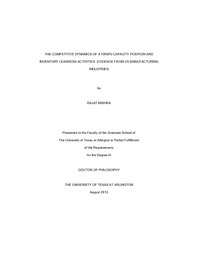
ATTENTION: The works hosted here are being migrated to a new repository that will consolidate resources, improve discoverability, and better show UTA's research impact on the global community. We will update authors as the migration progresses. Please see MavMatrix for more information.
Show simple item record
| dc.contributor.author | Mishra, Rajat | en_US |
| dc.date.accessioned | 2013-10-22T23:59:02Z | |
| dc.date.available | 2013-10-22T23:59:02Z | |
| dc.date.issued | 2013-10-22 | |
| dc.date.submitted | January 2013 | en_US |
| dc.identifier.other | DISS-12365 | en_US |
| dc.identifier.uri | http://hdl.handle.net/10106/23909 | |
| dc.description.abstract | The notion of `perennial gale of creative destruction' by Schumpeter and Austrian economics has been researched in the field of strategic management to study the competitive dynamics among firms' rivalrous activities. However, its application is sparse in operations management. With the advancement of the field and the increasing pressure on the firms, the strategies regarding operations planning and control are argued to be not just internal according to the conventional norms of operations management, but these strategic moves will be impacted by the moves of their immediate rivals. This competitive imitation is studied in the areas of inventory management and capacity management as these are the two main operations strategies. A two way relationship is examined to see how the leader firm's past inventory management and capacity management will affect the challenger firm's current inventory management and capacity management and how the challenger firm's past inventory management and capacity management will affect the leader firm's current inventory management and capacity management. The relationships of the leader and challenger firms are then investigated through two one sided tests as how the lagged inventory management and capacity management of a leader firm affects the challenger firm's current inventory management and capacity management and vice versa as two separate regressions. The leader and the challenger firms in an industry are respectively the firms holding the highest and second highest market share (Hofer, Cantor and Dai, 2012). Since, the concepts are clearly established at the enterprise level and since enterprise strategy is linked to operations strategy, the competitive actions and reactions that take place at the operations level appeared important to investigate. The variables like market share gap, industry growth and industry concentration will be examined to see if they have any moderating effects on this dynamic relationship. The study controls for the barriers to entry, diversification of firms and firm size. Apart from the Schumpeterian perspective and competitive dynamics theory, supports are drawn from theoretical frameworks such as Resource Based View, Transaction Cost Theory and also from signaling theory and from institutional theory. A 10 years Compustat data from 2001 to 2010 is used to examine the hypotheses. Data are analyzed using the econometrics panel data analysis where with the help of multiple OLS regressions the hypotheses are tested for top two firms of multiple industries across the years from 2001 through 2010. The results are significant to conclude that the main effects of the inventory management and the capacity management of the rival firms have a positive impact on the focal firm. This dynamic relationship triggered as a result of competitive imitation in inventory management is found to be significantly moderated by industry growth and sparsely by market share difference but industry concentration is found to be a non-significant moderator. On the contrary, in context to capacity management, the moderators industry concentration and market share difference has showed weak significance (significant at higher levels of significance) but industry growth has turned out to be insignificant. | en_US |
| dc.description.sponsorship | Frazier, Gregory | en_US |
| dc.language.iso | en | en_US |
| dc.publisher | Information Systems & Operations Management | en_US |
| dc.title | The Competitive Dynamics Of A Firm's Capacity Position And Inventory Leanness Activities: Evidence From US Manufacturing Industries | en_US |
| dc.type | Ph.D. | en_US |
| dc.contributor.committeeChair | Frazier, Gregory | en_US |
| dc.degree.department | Information Systems & Operations Management | en_US |
| dc.degree.discipline | Information Systems & Operations Management | en_US |
| dc.degree.grantor | University of Texas at Arlington | en_US |
| dc.degree.level | doctoral | en_US |
| dc.degree.name | Ph.D. | en_US |
Files in this item
- Name:
- Mishra_uta_2502D_12365.pdf
- Size:
- 1.901Mb
- Format:
- PDF
This item appears in the following Collection(s)
Show simple item record


